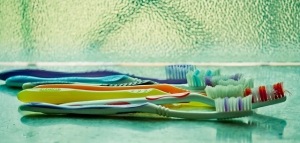Teaching Patients Appropriate Oral Hygiene Strategies
Brushing and Flossing – Do you know the basics?
“You don’t have to brush all your teeth every day. Only the ones you want to keep!”
Brushing
Good oral health starts with clean teeth. To prevent gum disease, it is important to keep the area where your teeth meet your gums clean. Keeping the surfaces of your teeth clean help prevent cavities. Follow these brushing basics from the American Dental Association to maintain healthy teeth:
- Brush your teeth at least twice a day.When you brush, don’t rush. Take enough time to do a thorough job.
- Use the proper equipment.Use a fluoride toothpaste and a soft-bristled toothbrush that fits your mouth comfortably. Consider using an electric or battery-operated toothbrush, which can reduce plaque and a mild form of gum disease (gingivitis) more than does manual brushing. These devices are also helpful if you have arthritis or other problems that make it difficult to brush effectively.
- Practice good technique.Hold your toothbrush at a slight angle — aiming the bristles toward the area where your tooth meets your gum. Gently brush with short back-and-forth motions. Remember to brush the outside, inside and chewing surfaces of your teeth, as well as your tongue.
- Keep your equipment clean.Always rinse your toothbrush with water after brushing. Store your toothbrush in an upright position, if possible, and allow it to air-dry until using it again. Don’t routinely cover toothbrushes or store them in closed containers, which can encourage the growth of bacteria.
- Know when to replace your toothbrush.Invest in a new toothbrush or a replacement head for your electric or battery-operated toothbrush every three to four months — or sooner if the bristles become frayed.
Flossing
Daily flossing is important to clean those hard-to-reach spots between your teeth and under the gumline. Follow these flossing basics to maintain healthy teeth:
- Don’t skimp.Break off about 18 inches (46 centimeters) of dental floss. Wind most of the floss around the middle finger on one hand, and the rest around the middle finger on the other hand. Grip the floss tightly between your thumbs and forefingers.
- Be gentle.Guide the floss between your teeth using a rubbing motion. Don’t snap the floss into your gums. When the floss reaches your gumline, curve it against one tooth.
- Take it one tooth at a time.Slide the floss into the space between your gum and tooth. Use the floss to gently rub the side of the tooth in an up-and-down motion. Unwind fresh floss as you progress to the rest of your teeth.
- Keep it up.If you find it hard to handle floss, use an interdental cleaner — such as a special wooden or plastic pick, stick or brush designed to clean between the teeth.
It doesn’t matter if you brush or floss first, however, flossing before brushing might allow more fluoride from your toothpaste to reach between your teeth.
When to see your dentist
Besides regular cleanings and exams, it is important to contact your dentist if you notice any of the following signs or symptoms:
- Red, tender or swollen gums
- Gums that bleed when you brush or floss
- Gums that begin pulling away from your teeth
- Loose permanent teeth
- Changes in the way your top and bottom teeth align with each other
- Unusual sensitivity to hot and cold
- Persistent bad breath or an unusual taste in your mouth
Good daily oral care is important to keep your teeth and mouth healthy. While brushing and flossing might seem like basic tasks, it is important to make sure you are following the correct procedures to maintain good oral health.
Contact Star of Texas Dental Assisting School for any general dentistry questions!
From Mayo Clinic and American Dental Association



